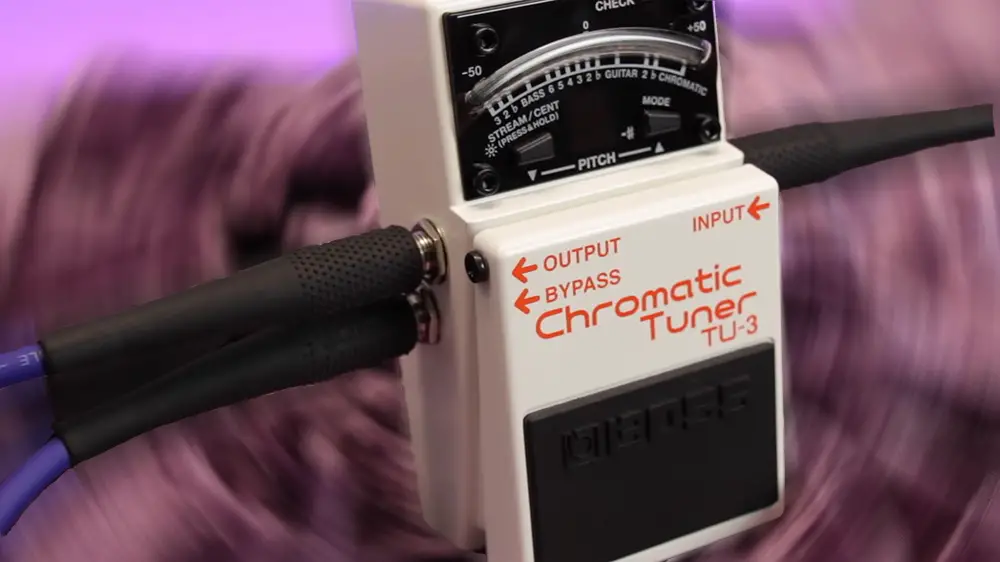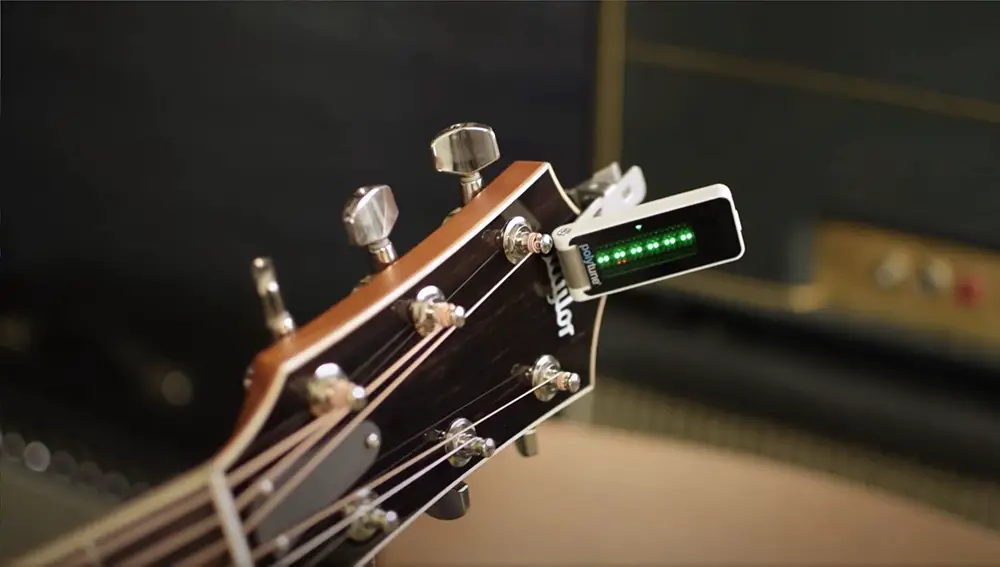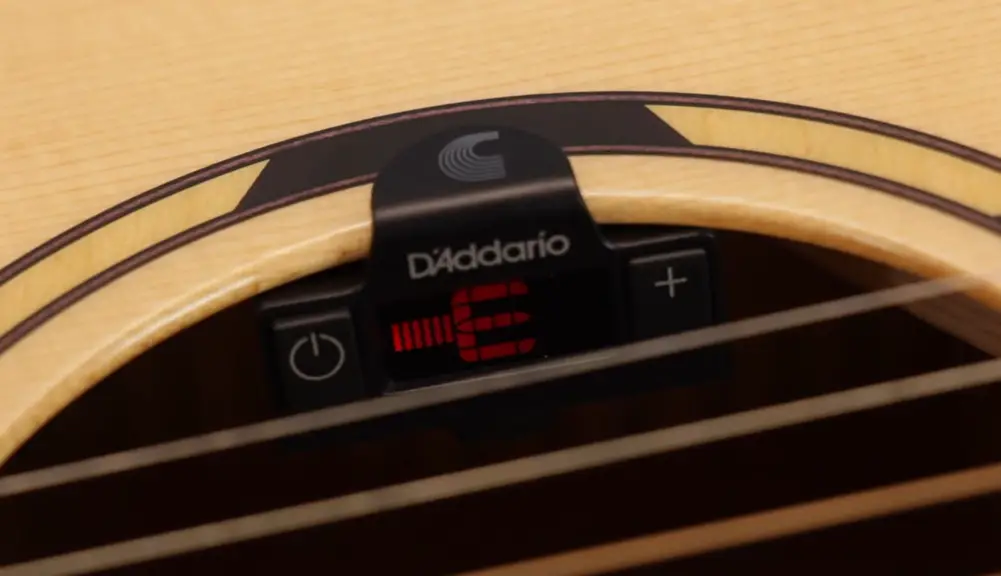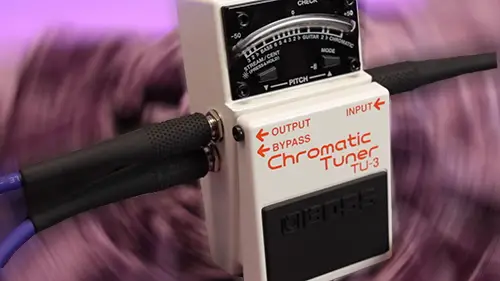Guitar tuners are a crucial part of any guitar player’s arsenal, and they’re the one guitar accessory that every guitar player needs.
These days, there are many types of guitar tuners available to choose from, but which one is right for you? First, let’s take a look at what all the options are:
- Handheld
- Clip-On
- Pedal
- Rackmount
- Soundhole (Acoustic)
- Smartphone App
- Strobe
This article will cover each of those types of tuners, how they interface with the guitar, and which one is best for you depending on how, where, and what you are playing.
I’ll also cover the different techniques that tuners use to determine the pitch. Aka, how a guitar tuner works. Let’s get started.

What kind of guitar tuners are there?
There are seven different types of tuners, each with its own pros and cons. The main difference between them is how they pick up the guitar signal and how they interface with the guitar.
The different kinds of guitar tuners are Handheld, Clip-On, Pedal, Rackmount, Soundhole (Acoustic), Smartphone App, and Strobe tuners.
So, now that you know what all the different types of guitar tuners are. Let’s take a look at how they each work.
Handheld Guitar Tuners
Handheld Guitar Tuners use either microphones or piezo pickups to sense vibrations from the guitar string. Many handheld tuners will also have an input jack to plug your electric guitar directly into it. The signal is then processed by onboard electronics, which sends it to an LCD display or LED screen for tuning purposes.
These tuners are very portable and can be used anywhere with ease because they do not require any extra gear like some of the other tuner styles do.
They also have the added benefit of being able to tune both acoustic guitars as well as electric guitars, making them one of the most versatile types available in today’s market.
A lot of these handheld units include a 1/4″ jack for connecting your electric guitar and a built-in microphone for picking up an acoustic guitar.
Handheld tuners can be basic tuners that only display the six notes used for standard guitar tuning, but you will often find that they are chromatic tuners capable of recognizing all 12 chromatic pitches.
Other features that handheld tuners may have included are a speaker that can produce a pitch so you can tune by ear, and some tuners even have built-in metronomes.

Clip-On Guitar Tuners
These tuners are very similar to handheld tuners. However, these clip on the side of your headstock and work by sensing vibrations in the string using a piezo sensor. Clip-on tuners can be used to tune both acoustic and electric guitars.
Clip-on tuners typically do not have as many features as other types of tuners, but they are very convenient to use.
Pedal Guitar Tuners
Pedal Guitar Tuners are essentially the same as Handheld Guitar Tuners, but they are placed in a pedal form. This type is ideal for guitarists who use a pedalboard or don’t want to have a tuner hanging around their neck or on their headstock.
Pedal tuners may be utilized in any noisy environment, including a concert hall, club, or any loud stage.
These tuners are typically enclosed in heavy-duty metal or plastic. They’re pedals, so they are made to be stomped on, and they can handle a beating that may come with gigging.
Pedal tuners utilize a foot-operated switch to toggle the device on and off. They vary from bare-bones to being fully loaded with features.
One feature to be aware of is if the tuner is buffered or true bypass. A true bypass design prevents the tuner from coloring your tone when it’s not in use. (More details later on.) That may sound like something you would always want, but that may not be the case if you have long cable runs.
Rackmount Guitar Tuners
Rackmount Guitar Tuners are designed to be mounted in a 19-inch rack, and they are designed to be housed in a rack for gigging guitarists to transport their whole rig in one protective case.

Soundhole (Acoustic) Guitar Tuners
As the name suggests, soundhole tuners are designed to be placed inside the acoustic guitar’s soundhole. These tuners use a piezo pickup to sense the vibration of the strings.
Rackmount tuners provide a large display that can be easily seen from anywhere on the stage if needed. Another benefit of the larger size is that rackmount tuners often have other advanced features, such as having multiple inputs and outputs. This allows multiple instruments to be tuned in one rig that may house equipment for multiple musicians.
Rackmount tuners are also helpful in a studio setting, where they can be placed in a rack with the other standard gear and just left there.
Smartphone App Guitar Tuners
As the name suggests, Smartphone app guitar tuners are apps that run on your smartphone. These tuners use the phone’s microphone to pick up the sound of the string being tuned.
Strobe Guitar Tuners
Strobe Guitar Tuners are the most accurate technology in guitar tuning. These tuners use a strobe light and sensors to determine the string’s pitch.
A little history for you. The first electronic instrument tuner, released in 1936, was a strobe tuner marketed as the Stroboconn. The Stroboconn provided amazingly accurate pitch measurement.
While incredibly accurate, mechanical stroboscopes are heavy and fragile, making them not very practical for everyday use or carrying around to your shows.
These days, the rotating disk has been replaced with an LED array strobe to create modern stroboscopic tuners, which provide the same results without moving mechanical parts.
It should be noted that the “strobe mode” on most LCD/LED tuners only emulates a stroboscope. It just provides a different kind of visual feedback, and they aren’t as precise as a strobe tuner.
How do guitar tuners work?
Now that you know all the different types of guitar tuners are, let’s look at how they work.
Guitar tuners measure the frequency created by a vibrating string. Guitar tuners use one of four methods to determine the string’s pitch: a piezo (vibration) sensor, a microphone, a direct connection, or a strobe light.
The most common type of tuner these days is the vibration sensor, or more technically known as a piezo sensor. This type of tuner senses the string’s vibrations and translates that into an voltage signal. Electronics then process the signal’s frequency, displaying the respective note.
For those engineers out there, the tuner converts the signal into frequency using Fast Fourier Transform (FFT) or some similar method.
I am not going to explain in detail what an FFT is because it is beyond the scope of this article. FFT is a mathematical method that converts a signal into individual spectral components and provides frequency information about the signal.
The FFT algorithm is widely used in many applications for science, music, engineering, etc.
After the microprocessor has detected the frequency, it compares the generated frequency with a stored value that serves as a reference value. The standard is A-440, although most tuners allow you to adjust the frequency.
What is Concert Pitch?
Concert pitch, also known as standard pitch, is a method of standardizing pitch used across the world. When an instrument is tuned to concert pitch, it is tuned to the A above middle C, which has a frequency of 440Hz.
440Hz has long been recognized as the standard frequency, although other variations have been used since the concept was first developed in the early 19th century.
The guitar’s open strings have the following frequencies when tuned to concert pitch:
| Guitar String | Frequency |
| 6th String (Low E) | 82.4Hz |
| 5th String (A) | 110Hz |
| 4th String (D) | 146.8Hz |
| 3rd String (G) | 196.0Hz |
| 2nd String (B) | 246.9Hz |
| 1st String (high E) | 329.6Hz |
Notice that the A string is 110 Hz, whereas concert pitch uses the A above middle C, which is 440 Hz. 110 Hz is two octaves below 440 Hz. If you divide 440 by 2, and then by 2 again, you get to 110.
That’s how octaves work. If you double a frequency, the pitch is one octave higher.
How do piezo tuners work?
Examples of piezo tuners would be clip-on tuners or soundhole tuners. You may see branding like “High-sensitivity vibration sensor.” This means that the tuner is using a piezo sensor.
Basically, any tuner you don’t plug into and doesn’t have a microphone uses a piezo sensor.
Piezo tuners use a piezoelectric transducer to detect vibrations, which is then amplified and converted into an electrical signal using an analog-to-digital converter. The processor converts the pitch into frequency, showing the result on a display.
How do plug-in tuners work?
Examples of plug-in tuners would be pedal tuners or rackmount tuners and some handheld tuners. Any tuner where you are physically plugging in your instrument cable is a plug-in tuner.
Plug-in tuners receive the signal directly from the instrument, and the signal is then amplified and converted into an electrical signal using an analog-to-digital converter. The processor converts the pitch into frequency, showing the result on a display.
How do microphone based tuners work?
Today, the most common example of microphone-based tuners is the smartphone and tuning apps that run on the smartphone.
Microphone tuners use a microphone to detect sound vibrations, which is then amplified and converted into an electrical signal using an analog-to-digital converter. The processor converts the pitch into frequency, showing the result on a display.
Microphones in your smartphone are another type of piezoelectric sensor. The tuning apps use your phone’s processing power to convert the signal using FFT and display the note and frequency on the screen.
How do strobe tuners work?
Strobe tuners work differently than other guitar tuners do.
Strobe tuners use the instrument’s signal to drive a strobe light that flashes at the same frequency as the input signal. The instrument is usually connected using a 1/4″ inch cable.
For example, the frequency of the G-string when using concert tuning is 196 Hz. If you play the G-string and it is perfectly in tune, the strobe light would flash precisely 196 times per second.
The strobe tuner has a disc that spins at a specific rate depending on the desired frequency. If the strobe light frequency matches the disc, the disc will appear to be stopped, meaning the string is in tune.
If not in perfect tune, the disc will appear to be rotating. The faster it seems to revolve, the more out of tune you are. The wheel will appear to slow down as you approach the correct note.
The direction that the disc appears to be spinning will tell you if your string is sharp or flat.
Strobe tuners are very accurate, up to 1/10000th of a semitone. They’re also costly.
Here is a great video that explains how strobe tuners work.
Chromatic tuners versus non-chromatic tuners
What is a chromatic tuner?
A chromatic tuner displays the pitch of the note you are playing relative to the nearest note of the chromatic scale: C, C#, D, D#, E, F, F#, G, G#, A, A#, B.
The Chromatic Scale is a scale composed entirely of half-steps.
You’ll see chromatic tuning on many tuners, but not all of them. Now that you know what chromatic means, a non-chromatic guitar tuner is just as it sounds: a tuning device designed solely to tune a guitar to the standard EADGBE tuning and no other notes.
These tuners will often have a switch for selecting which note you are tuning to. The tuner will only indicate how sharp or flat the string is in relation to the selected note.
A chromatic tuner will show tuning relative to the nearest note in the chromatic scale. This means you have to know that standard tuning is EADGBE, but it also means you can tune to alternate tuning as well.
It also makes it possible to tune instruments other than a guitar that are tuned to different standard tunings than a guitar. For example, a ukulele.
If you are only ever going to tune to standard guitar tuning, then a non-chromatic tuner will be fine, but I’d suggest a chromatic tuner. They’re about the same price and are far more flexible.
Polyphonic tuners: What is a polyphonic tuner?
Polyphonic tuners are a relatively recent innovation. TC Electronics initially developed the technology when they released the Polytune pedal, and they now have a clip-on version as well.
A standard guitar tuner allows the user only to tune a guitar one string at a time. A polyphonic tuner allows the player to strum all the strings simultaneously and see the separate tuning of each string all at the same time.
If you have never seen this, it can be a little hard to imagine how they can present you with all that information at once. So, here is a video demonstrating the TC Electronics Polytune clip-on tuner.
Buffered vs. True Bypass Tuners
A true bypass pedal allows the tone and signal of your guitar to flow through unaffected when the pedal is off. This means that your guitar’s tone is preserved – the pedal does not color it at all when it’s not being used.
Buffered bypass is where part of the circuit stays in the signal path whether the main circuit of the pedal is active or not.
Guitarworld.com has a good article on bypass types located here. https://www.guitarworld.com/features/true-bypass-vs-buffered-bypass
Or you can watch this video:


